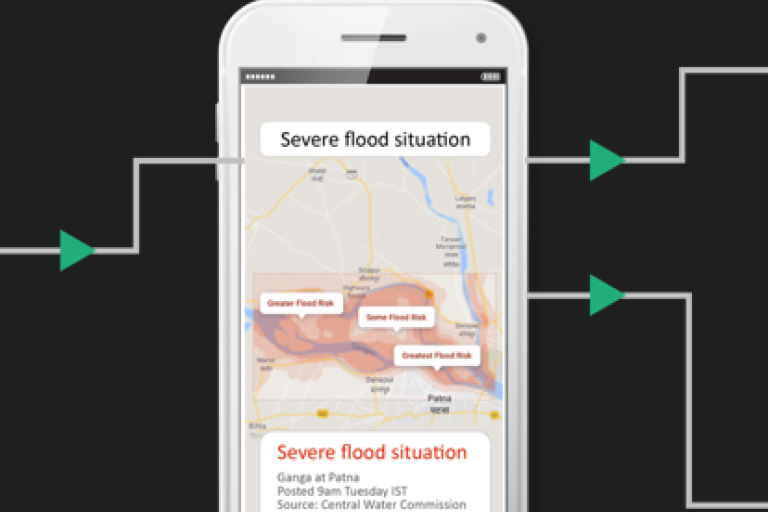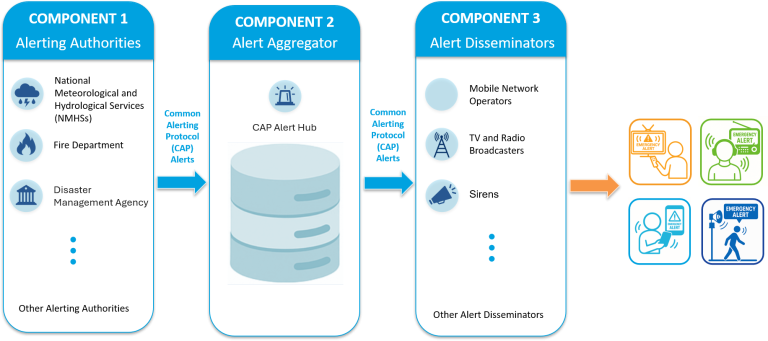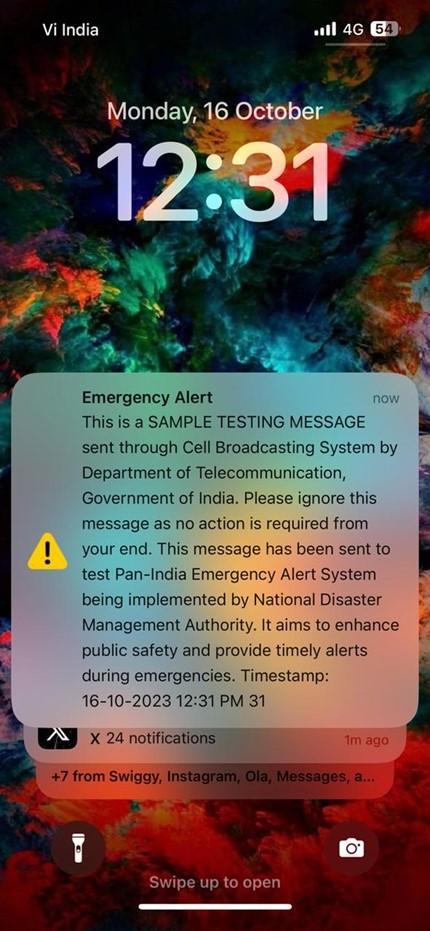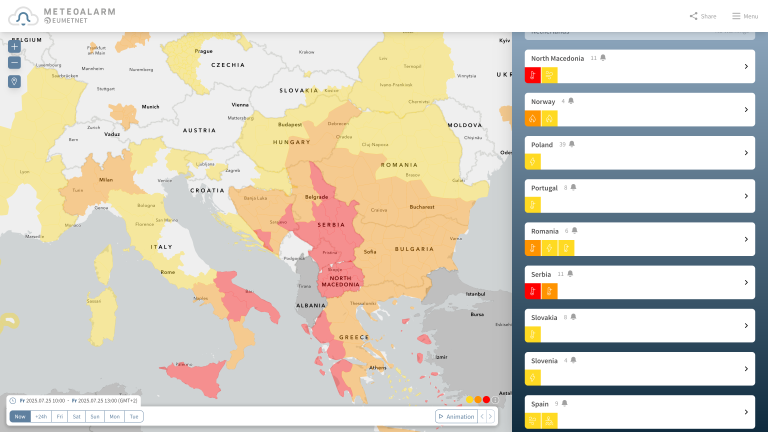Leveraging the Common Alerting Protocol and Cell Broadcast Technology for Advancing Early Warnings for All
- Author(s):
- By Vanessa Gray, International Telecommunication Union (ITU), Bryce Hartley, GSMA, Elysa Jones, OASIS-Open, Joseph Siegl, MeteoAlarm, Sankar Nath, India Meteorological Department (IMD), and Adanna Robertson-Quimby and Vicente Vásquez from the WMO Secretariat

The accelerating pace of disasters has underscored the urgent need for effective early warning systems, which are proven lifesavers that dramatically reduce disaster losses. In 2022, the United Nations Secretary-General launched the Early Warnings for All initiative, aiming to ensure that every person on Earth is protected by an early warning system, as a key component of disaster risk reduction and climate adaptation.
A key focus of the initiative is Warning Dissemination and Communication, which emphasizes that people at risk must receive timely, accurate, actionable alerts via channels they consider reliable and accessible. To that end, modern digital communication standards, such as the Common Alerting Protocol (CAP) and Cell Broadcast, have emerged as critical enablers for reaching everyone quickly and consistently.
CAP is an open, structured data standard for alerts that allows a single warning message to be distributed simultaneously over multiple media and platforms. Cell Broadcast is a telecommunications service that can transmit urgent messages to all mobile phones in a defined area within seconds, even if networks are congested or individual users are not subscribed to any alert service. Together, these tools support the operational delivery of Warning Dissemination and Communication under Early Warnings for All. CAP standardizes the content of the message, while Cell Broadcast maximizes its reach and speed of delivery.
About Common Alerting Protocol
CAP is an international standard for communicating hazard alert information. Adopted as ITU Recommendation X.1303, CAP defines a consistent, machine-readable data format (XML) for all-hazard, all-media alerts. Considered a “universal adapter” for disseminating warnings, CAP replaces the many siloed interfaces that used to exist between each hazard source and each communication channel, allowing one standard message to feed any and all dissemination channels.
The standard allows for key information about any emergency, whether a cyclone, flood, earthquake, wildfire or public health event including the event type, severity or urgency, geographic area (with geocodes or polygons), expected time frame and recommended protective actions. This all-hazards flexibility means that every agency and threat type can use the same format without losing specificity.
A core value of CAP is interoperability, as CAP messages can be delivered simultaneously over multiple channels, including mobile networks, radio and television broadcasts, sirens, Internet feeds, mobile apps, email and social media. This multichannel capability increases coverage, reinforces public trust and ensures that alerts reach people even if one pathway fails.
Moreover, the structured data of CAP enables automatic translation and accessibility adaptations. For example, message elements can be readily translated into multiple languages or converted into audio or visual formats for people with disabilities. These features enhance the inclusiveness of public warning systems, a priority of the Early Warnings for All initiative. CAP also streamlines the alerting workflow for authorities, improving both speed and consistency during fast-moving emergencies. Authorized agencies can generate structured alerts through a single Alert Origination Interface (AOI) publish to a centralized aggregator or alert hub, and automatically trigger distribution across all subscribed dissemination channels (See Figure 1). The streamlined process helps to ensure that alerts are delivered rapidly and uniformly to populations at risk.

For years, WMO encouraged the adoption of CAP and in 2023 the Nineteenth World Meteorological Congress approved the inclusion of CAP in the Technical Regulations, Volume I: General Meteorological Standards and Recommended Practices (WMO-No. 49). CAP is now a recommended standard for the routine dissemination of warnings in the WMO-No.49. ITU has encouraged redistributors, including Mobile Network Operators (MNOs) and broadcasters, to adopt CAP for the global dissemination of life-saving alerts. At the 28th session of the Conferences of Parties (COP28) to the United Nations Framework Convention on Climate Change (UNFCCC), ITU and GSMA jointly launched a call to action to deploy Cell Broadcast and location-based SMS. As a result, many operators including VEON, KDDI, Globe, Safaricom, Telefónica, MTN and Axiata Group committed to harnessing digital connectivity to save lives.
The WMO Register of Alerting Authorities (RAA), developed by WMO and ITU provides a unique designator to verify and identify trusted institutions responsible for issuing alerts. This is used in the CAP messages of authorized sending entities to reinforce their credibility and public confidence. This safeguard ensures that CAP-enabled warnings come from recognized, authoritative sources, which helps early warnings achieve their ultimate purpose, saving lives and protecting communities. These CAP messages are also displayed on the Severe Weather Information Centre (SWIC), to enhance the availability of authoritative warnings and information related to extremes and/or potentially high-impact weather, water and climate events.
New approaches are further accelerating CAP adoption by tailoring support to country-specific needs, reinforcing existing infrastructure, and fostering collaborative networks. Through the support of WMO and key partners, regional trainers now share their expertise through practical, hands-on workshops that feature peer exchanges, real-time alert formatting, stakeholder engagement and innovative training activities. This sharing of knowledge and trust building give way to a vibrant regional community of practice, united by a common “early warning” language. Through Early Warnings for All, partners have delivered joint CAP trainings, strengthening communication, community outreach and actionable messaging.
At the centre of this effort, is the CAP Composer a free, open-source and user-friendly tool that enables official authorities to create and disseminate lifesaving alerts across phones, radio, TV and the web. A major milestone is its integration with the WMO Information System (WIS 2.0), via the WIS2 in a Box software. WIS 2.0 is a global system for seamless, real-time sharing of Earth system data and services, including CAP messages from registered alerting authorities. This integration allows anyone, from national authorities to MNOs, to subscribe and receive alerts without needing their own infrastructure. The MNOs then process these CAP messages through their Cell Broadcast Centres and deliver them to devices located within the alert area. Training and testing environments for national alerting authorities also ensure CAP messages remain accurate, standardized and reliable.
Together, these innovations are transforming how alerts are created, shared and received, ensuring that communities worldwide get the right information at the right time to stay safe.
A key feature of the new WMO Early Warning Services Technical Regulations (EWS-TR) is the requirement to use CAP for warning dissemination. By embedding CAP, the regulations ensure that warnings are not only science-based but also effectively reach populations at risk through trusted and accessible means. Equally important, the EWS-TR establishes the RAA as the official source for trusted, verified entities authorized to issue warnings. Together, CAP and the RAA strengthen the credibility, consistency and effectiveness of early warning dissemination, aligning with the Early Warnings for All initiative and safeguarding lives and livelihoods across the globe.
Explanation of Cell Broadcast as a dissemination channel
While CAP standardizes the content and structure of warning messages, effective early warning also requires robust, high-speed delivery channels to reach large populations, instantly and reliably. One such channel that has gained prominence is Cell Broadcast technology.
Notably, Cell Broadcast does not require users to subscribe, download apps or have Internet access. Any compatible phone that is powered on in the area will automatically receive the alert. This makes Cell Broadcasting a highly inclusive and effective tool for reaching residents, visitors, travelers and individuals without local mobile subscriptions. Many features of Cell Broadcast make it an ideal tool for early warnings:
Geographic precision: alerts are sent to all mobile devices located within a specific geographic area, regardless of SIM activation. Alerts reach only devices within the defined danger zone, including tourists without roaming services, reducing unnecessary panic.
- Real-time speed: messages are delivered almost instantly, unaffected by network congestion.
- Privacy-friendly: Cell Broadcast is a ‘blind’ technology that does not collect or store recipient data. Hence, who has received or responded to the messages cannot be tracked.
- Distinct alert tones and vibrations: through the use of a unique sound, vibration and display Cell Broadcast ensures recognition, even in silent mode or noisy environments, and are accessible for people with impairments.
- Message displays: alerts appear automatically on screen and remain until acknowledged. • Ease of use: Unlike app-based systems, Cell Broadcast does not require pre-installed software or user subscriptions and can reach virtually all devices connected to the cellular network that support this feature, including most basic phones.
- Repeated broadcasting: messages can be re-broadcast so late arrivers in the location still receive alerts while avoiding duplicate notifications for those already alerted. • Authenticity and security: only authorized authorities can send Cell Broadcast alerts, making them highly resistant to spoofing and increasing trust.
Technically, Cell Broadcasting has been part of mobile network standards (GSM/3GPP) for decades, but its use in public warning gained traction only in recent years. A major turning point was the 2018 EU directive, which required all Member States to implement population-wide mobile alerting systems (either via Cell Broadcast or Location-based SMS) by 2022. This spurred wide adoption across Europe and inspired similar mandates elsewhere.
As of early 2025, around 44 countries, primarily high-income economies, have operational Cell Broadcast systems or are in the process of deploying them. However, most countries still lack access to Cell Broadcast-based alerting. Bridging this gap is a priority under Early Warnings for All, which seeks to expand these technologies in regions most vulnerable to climate and disaster risks.
With mobile networks now covering nearly 98% of the global population and mobile phone ownership reaching 80%, Cell Broadcast presents an important opportunity to bridge the “last mile” in warning dissemination.
| Case Study: CAP and Cell Broadcast in India | |
|---|---|
In India, the National Disaster Management Authority (NDMA) manages all relief, risk, mitigation and related activities. NDMA with the India Meteorological Department (IMD), developed a CAP-based Early Warning System. The system brings all disaster-related agencies under one framework, enabling quick, coordinated alerts through multiple channels and reducing delays in disaster response. The Department of Telecommunications, in partnership with NDMA, is strengthening the mobile-based disaster communication systems in India to deliver timely alerts to citizens. NDMA has operationalized the Integrated Alert System (SACHET), developed by Centre of Development of Telematics (C-DOT,) based on the internationally recommended CAP standard. Now active across all 36 States and Union Territories, the system has already issued over 68.99 billion geo-targeted SMS alerts in more than 19 Indian languages during cyclones, floods and other emergencies. To enhance speed and reliability, Cell Broadcast technology is also being introduced, enabling near real-time delivery of alerts directly to mobile phones in affected areas. C-DOT is leading the indigenous development of this advanced public emergency alerting system. The CAP-based Early Warning System has significantly strengthened disaster mitigation and response frameworks in India by standardizing alerts for real-time dissemination across multiple channels. IMD warnings now reach targeted users more quickly, enabling faster action and improving coordination among disaster managers through a fully digital platform. A centralized dashboard provides real-time monitoring of warnings, SMS volumes and notifications, helping authorities act with greater efficiency. Recognizing that SMS alone is insufficient, NDMA has also launched a national disaster alert portal (sachet.ndma.gov.in) and the SACHET mobile app, expanding alert delivery to web browsers and mobile handsets and advancing the vision of “early warning for all”. Since the adoption of CAP, IMD has been issuing cyclone warnings 5–7 days in advance, enabling timely preparedness. During recent cyclones, millions of geo-targeted SMS alerts were sent as shown in the table below. Table 1. Millions of CAP-based SMS sent during cyclones | 
Example of Cell Broadcast message
|
| Recent cyclones | Total SMS sent (millions) |
| Remal | 237 |
| Mocha | 13 |
| Biparjoy | 320 |
| Michuang | 447 |
Advancing Cell Broadcast technology adoption is therefore essential not only for achieving the Early Warnings for All goal of universal coverage by 2027 but also for protecting vulnerable communities on the frontlines of climate and disaster risks. Multichannel EWS are essential to ensure everyone everywhere can be reached with emergency warnings. Cell Broadcast is one dissemination channel with many advantages and is most effective when used in conjunction with other digital and analogue dissemination channels. More details about Cell Broadcast and its role in EWS can be found in Cell Broadcast for Early Warning Systems: A review of the technology and how to implement it. In some instances when mobile networks fail during disasters, the ITU-supported emergency.lu satellite-based platform, seamlessly ensures vital communications remain operational.
CAP at the core: How MeteoAlarm delivers a shared voice for weather warnings across Europe
Launched in 2006, MeteoAlarm has evolved from a simple website into a continent-wide platform for sharing weather-related danger alerts. Today, it and Hydrological Services (NMHSs), and issues warnings in 37 languages, with countless global redistributors amplifying its reach. The system provides early warnings up to five days in advance, giving people more time to prepare for severe weather events. National alerting authorities issue CAP messages that are sent to the MeteoAlarm hub for redistribution by platforms such as Google, Apple, AccuWeather and The Weather Channel.
From there, warnings appear in multiple forms: push notifications on mobile phones, markers on interactive maps, weather app updates or alerts integrated into navigation systems. This unified standard guarantees that critical warnings are timely, reliable and accessible to people everywhere in Europe. The greatest strength of MeteoAlarm lies in its harmonized approach. With a standardized framework, people across Europe can interpret complex weather warnings more clearly and consistently. The MeteoAlarm CAP Profile was developed to strike a balance between common rules and country-specific flexibility, with experts continuously refining the system to meet new challenges.
Warnings are communicated through a simple three-tier colour code: yellow for moderate, orange for severe and red for extreme conditions. They currently cover 14 common weather and water-related hazards across Europe. The latest CAP Profile (v2.0) goes further, allowing members to add Impact Statements, explaining not only what the weather will be, but what it will do. By separating meteorological details and probabilities, information is now presented in a clearer, more structured way.
Since weather hazards know no borders, MeteoAlarm fosters cross-border cooperation, ensuring warnings are uniform and trusted across Europe. For the public, the aim is simple: whether at home or traveling abroad within Europe, alerts should look the same, be easy to understand, and support safe decision-making. In essence, MeteoAlarm gives Europe a shared voice for weather warnings when it matters most. Figure 2 shows an example of successful cross-border harmonization through CAP implementation.

Conclusion and recommendations
CAP standardizes the content of alerts across systems, while Cell Broadcast ensures that alerts are delivered rapidly and reliably to affected populations, even in the absence of Internet access, regardless of language or literacy and without the need for registration. When implemented effectively, these tools make early warnings actionable, inclusive and scalable to reach millions within seconds.
CAP and Cell Broadcast technology have proven to be powerful enablers of early warning systems, particularly in closing the last-mile gap in public warning systems. Both CAP and Cell Broadcast have been in operational use for over 20 years, demonstrating their critical value across diverse national contexts. Experiences from India, Europe and other regions underscore the importance of robust coordination among stakeholders including NMHSs, disaster management authorities, telecommunication regulators, MNOs and the media. Without cross-sectoral governance, even the best-designed warning systems may fail to reach or prompt action among those most at risk. The following are some key recommendations for consideration:
- Adoption of CAP as a national standard for the routine dissemination of warnings, promoting consistency, interoperability and scalability.
- Prioritize mobile-based dissemination and consider Cell Broadcast, to deliver fast, reliable, and wide-reaching alerts, supported by clear roles, responsibilities and operating procedures.
- Build enabling environments by reinforcing legal frameworks, designating alerting authorities, defining activation and early action protocols and investing in public awareness and preparedness.
- Foster partnerships among governments, MNOs, ICT regulators, civil protection agencies, alerting authorities, international organizations and key stakeholder organizations to design, test and operate CAP-based systems effectively.
The expansion of digital networks has made it possible to deliver life-saving information to almost everyone, but this potential can only be realized through political will, sustained investment and above all, a collective commitment to preparedness as a public good. CAP and Cell Broadcast demonstrate how digital innovation can directly protect lives. Scaling up these systems is essential to ensure that everyone receives timely alerts when it matters most.
References
GSMA, Cell Broadcast for Early Warning Systems: A review of the technology and how to implement it, 2023
GSMA, India’s SACHET Public Warning System: A Case Study in Mobile Alerting, 2025


